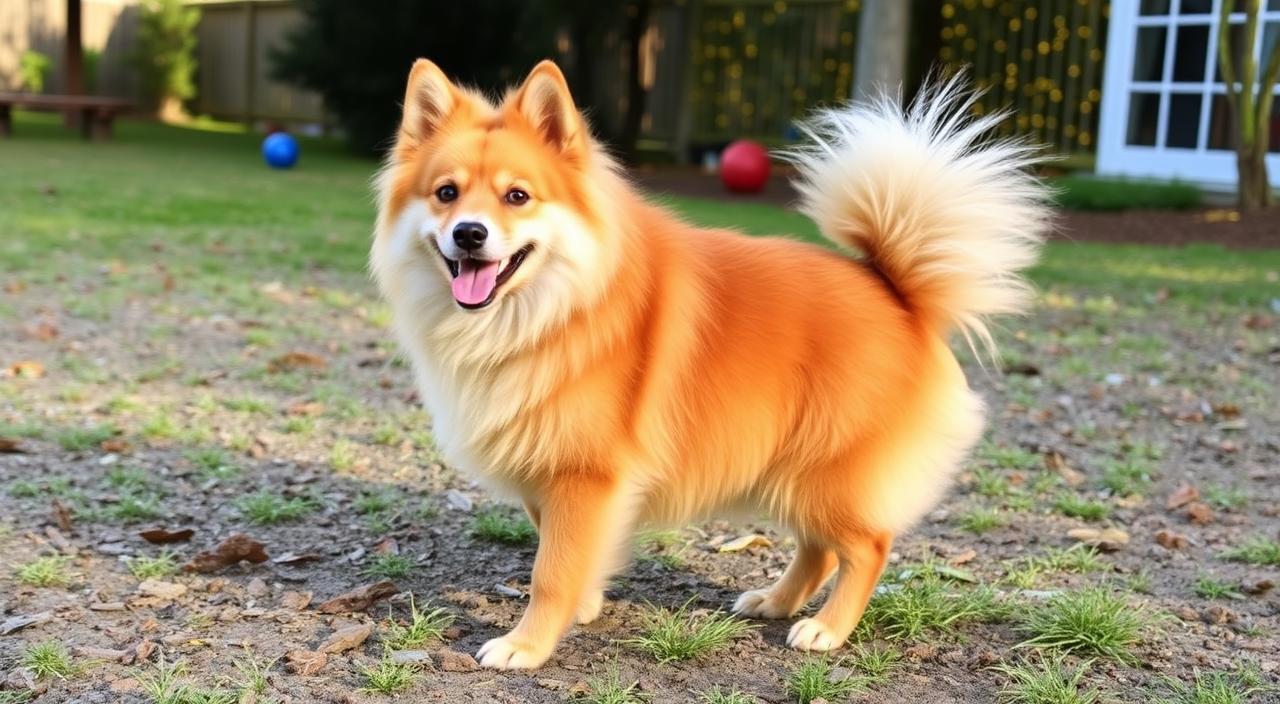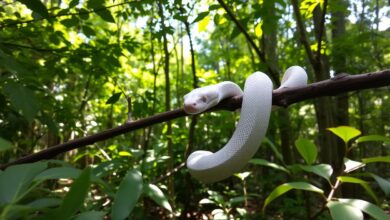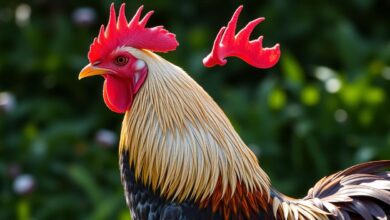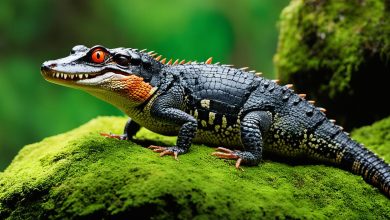My Finnish Spitz, Finn, chases butterflies in our backyard. His golden-red coat gleams in the sunlight. This lively breed brings joy, showcasing the special bond between humans and dogs.
The Finnish Spitz hails from Finland and has a fox-like appearance. These medium-sized dogs stand 15 to 20 inches tall. They weigh between 20 to 33 pounds.
Finnish Spitz dogs are intelligent and eager to learn. They make excellent family pets due to their friendly nature. Their blend of loyalty and independence endears them to dog lovers.
These dogs were originally bred as hunting companions in Finland’s forests. Now, they’ve become versatile pets. They excel as watchdogs and loving family members.
Finnish Spitz dogs have a lifespan of 13 to 15 years. They’re perfect for active outdoor adventures. These loyal friends can brighten your days for years to come.
The Finnish Spitz: An Overview
The Finnish Spitz is a unique nordic breed with a rich history. It stands out among other hunting dogs like the finnish lapphund and karelian bear dog. This lively canine has been important in Finland’s culture for thousands of years.
Origin and History
The Finnish Spitz originated in Finland about 3,000 years ago. In 1880, it almost went extinct due to crossbreeding. Interestingly, this breed shares DNA with the extinct Taimyr Wolf.
Over time, it had many names. These included “Finnish cock-eared dog” and “Finnish Barking Birddogs”. Its past is truly fascinating.
Physical Characteristics
Finnish Spitz dogs have a unique look:
- Males stand 44-50 cm tall, females 39-45 cm
- Males weigh 12-13 kg, females 7.3-10 kg
- Coat colors range from pale honey to dark chestnut
- Puppies are born dark and lighten to red within two years
Temperament and Personality
Finnish Spitz dogs have special traits:
- Active and lively, requiring daily long walks
- Good with children, playful and protective
- Frequent barkers, capable of 160 barks per minute
- Independent and intelligent, responding to positive reinforcement
These traits make the Finnish Spitz a delightful companion. It combines the best qualities of nordic breeds like the finnish lapphund and karelian bear dog.
| Trait | Finnish Spitz | Finnish Lapphund | Karelian Bear Dog |
|---|---|---|---|
| Origin | Finland | Finland | Finland |
| Primary Use | Bird Hunting | Herding | Big Game Hunting |
| Size | Medium | Medium | Medium-Large |
| Coat Color | Golden-Red | Various | Black and White |
| Temperament | Lively, Vocal | Friendly, Calm | Brave, Independent |
Finnish Spitz as a National Treasure
The Finnish Spitz is Finland’s national dog, known as Suomenpystykorva in Finnish. It gained this honor in 1979. The Finnish Kennel Club worked hard to preserve and promote this beloved breed.
By 1880, the Finnish Spitz almost went extinct. Hugo Sandberg and Hugo Roos stepped in to save these charming dogs. Their efforts ensured the breed’s survival for future generations.
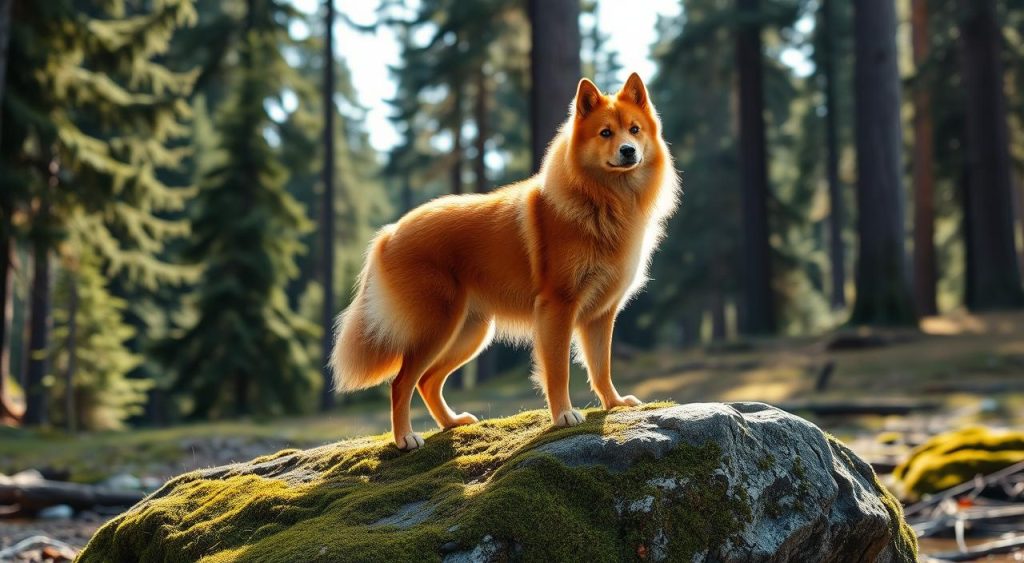
The Finnish Spitz symbolizes Finland’s cultural heritage. Its fox-like looks and red-gold coat reflect Finland’s wild beauty. These dogs are loyal, smart, and known for their unique “yodeling” bark.
| Characteristic | Description |
|---|---|
| Lifespan | 12-15 years |
| Temperament | Loyal, intelligent, alert |
| Ideal Height (Male) | 44-50 cm |
| Ideal Height (Female) | 39-45 cm |
| National Dog Status | Declared in 1979 |
The Finnish Spitz has worn many hats throughout history. It’s been a hunting buddy, a family pet, and now a national icon. Dog lovers worldwide admire its charm and rich heritage.
The Unique Hunting Heritage of Finnish Spitz
Finnish Spitz dogs have a rich hunting history in Finnish culture. These intelligent companions have excelled in bird hunting for centuries. Their adaptability and skills make them prized hunting partners.
Barking Hunting Dogs
Finnish Spitz are famous for their distinctive barking during hunts. They can bark up to 160 times per minute, a remarkable trait. This skill is celebrated in Finland’s national barking competitions.
The highlight of these events is crowning ‘The King of the Barkers’. Judges evaluate dogs on their ability to find birds and their barking frequency.
Specialized Bird Hunting Techniques
Finnish Spitz use a unique strategy to hunt birds. They run back and forth, sway their tails, and bark loudly. This method effectively attracts game birds in Finland’s dense forests.
Adaptability to Various Game
Finnish Spitz excel at bird hunting but can adapt to other game too. In the past, they even hunted elk and bears. Today, they navigate diverse terrains with ease.
These versatile dogs can hunt in moss-covered boulders and marshlands. Their adaptability makes them excellent companions for various hunting scenarios.
| Characteristic | Description |
|---|---|
| Primary Hunting Role | Bird hunting (Capercaillie, Grouse) |
| Hunting Style | Barking, running, tail swaying |
| Bark Frequency | Up to 160 times per minute |
| Preferred Hunting Environment | Finnish forests |
| Historical Prey | Birds, elk, bears |
Physical Attributes and Appearance
Finnish Spitz dogs have a fox-like look and medium size. They show a square, balanced body shape. Males stand 17.5 to 20 inches tall and weigh 31 to 35 pounds.
Females are slightly smaller at 15.5 to 18 inches tall. They weigh between 22 and 29 pounds. These dogs have a unique double coat.
Their coat has a soft undercoat and a harsh outer layer. Fur colors range from pale honey to deep auburn. Finnish Spitz puppies are born with black hairs that fade as they grow.

These dogs have a black nose and thin black lips. Their ears are erect and pointed. The Finnish Spitz’s most striking feature is its plumed tail.
Their tail curls elegantly over their back. This tail and their fox-like face give Finnish Spitz dogs their charming look.
| Feature | Description |
|---|---|
| Body Structure | Square, well-balanced |
| Coat Type | Double coat (dense undercoat, harsh outer coat) |
| Coat Color | Pale honey to deep auburn |
| Nose and Lips | Black |
| Ears | Erect, pointed |
| Tail | Plumed, curled over back |
Finnish Spitz Temperament and Behavior
Finnish Spitz dogs are known for their unique temperament. They blend intelligence and liveliness, making them great family pets. These medium-sized dogs stand 15-20 inches tall with a vibrant red-gold double coat.
Intelligence and Trainability
Finnish Spitz dogs learn quickly but can be stubborn. Their independent nature makes training challenging. Owners need patience and positive reinforcement to guide these smart pups effectively.
Social Nature and Family Compatibility
Finnish Spitz excel as family dogs. They’re playful, loyal, and alert. These dogs thrive in calm households due to their sensitivity.
They form strong bonds with their families. However, they may be cautious around strangers.
Interaction with Children and Other Pets
Finnish Spitz generally get along well with children. Their high energy matches kids’ playfulness. However, their hunting instincts might lead to chasing smaller pets.
Early socialization is key to prevent aggression towards other animals.
| Trait | Description |
|---|---|
| Barking | 2.5 barks per second, high-pitched and rapid |
| Energy Level | High, requires plenty of exercise |
| Sensitivity | High, reacts to stress and loud voices |
| Separation Anxiety | Prone to anxiety when left alone for long periods |
The Finnish Spitz’s unique temperament is crucial for potential owners to understand. Their lively nature, sensitivity, and intelligence make them engaging companions. These traits make them suitable for the right families.
Exercise Needs and Activity Level
Finnish Spitz dogs are energetic and need lots of exercise. They thrive on daily physical activity to stay healthy and happy. These canines require a commitment to regular exercise routines.
Finnish Spitz dogs need 60-90 minutes of physical activity daily. This can include brisk walks, jogs, or fun play sessions. A varied exercise plan keeps them mentally sharp and physically fit.
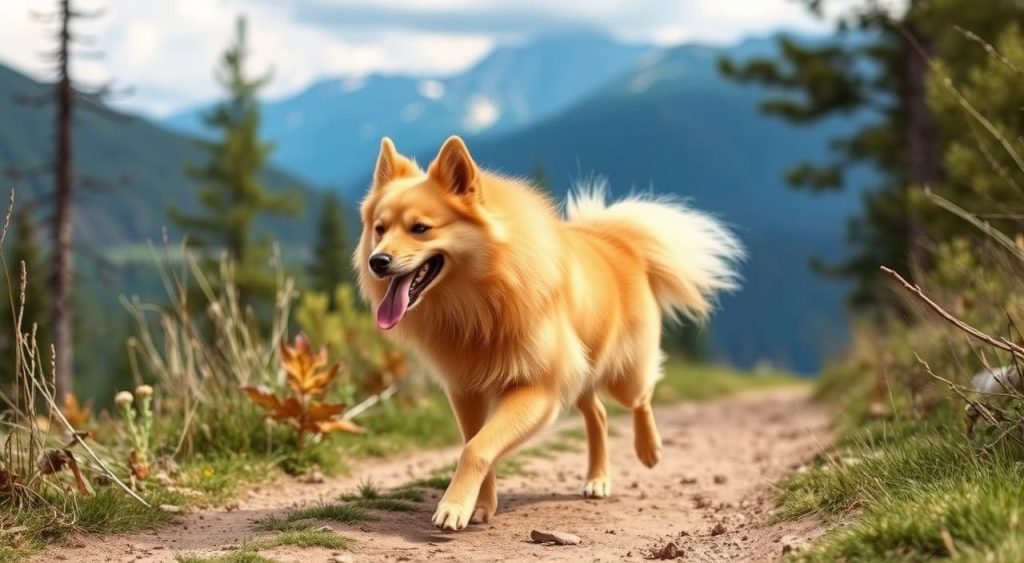
Owners should mix up activities for their Finnish Spitz. Here are some great options:
- Long bike rides
- Daily running sessions
- Agility exercises
These activities keep Finnish Spitz dogs fit and mentally stimulated. They love outdoor adventures, making them great for hikers or active families.
| Activity Level | Exercise Duration | Frequency |
|---|---|---|
| High | 60-90 minutes | Daily |
A well-exercised Finnish Spitz is a happy, well-behaved companion. Regular activity helps manage their high energy levels. It also reduces destructive behaviors caused by boredom or pent-up energy.
Grooming and Coat Care for Finnish Spitz
Finnish Spitz dogs boast stunning red-gold coats, from pale honey to dark auburn. These lively companions need minimal grooming. This makes them ideal for owners who prefer low-maintenance pets.
Brushing Frequency
Weekly brushing keeps Finnish Spitz coats healthy. During spring and fall shedding seasons, brush more often. A pin brush works best for their double coat.
It helps spread natural oils and remove dead hair. This keeps their coat looking its best.
Bathing and General Hygiene
Finnish Spitz dogs are naturally clean animals. They only need baths when visibly dirty. This helps preserve their coat’s natural oils.
Regular nail trimming is important for their comfort. Daily tooth brushing keeps their mouth healthy.
Shedding Seasons and Management
These dogs shed heavily twice a year. Daily brushing during these times helps control loose fur. Their double coat regulates body temperature.
Never shave a Finnish Spitz. It could harm their natural temperature control.
| Grooming Task | Frequency | Notes |
|---|---|---|
| Brushing | Weekly (Daily during shedding) | Use a pin brush |
| Bathing | As needed | Only when visibly dirty |
| Nail Trimming | Monthly | Or as needed |
| Tooth Brushing | Daily | For optimal dental health |
Health Considerations for Finnish Spitz
Finnish Spitz dogs are generally healthy, living 11 to 15 years. However, they can face breed-specific health issues. Owners should be aware of these to keep their dogs healthy.
Hip dysplasia affects about 6% of Finnish Spitz dogs. They’re also prone to luxating patella, a condition involving loose knee joints. Regular vet check-ups can help catch these problems early.
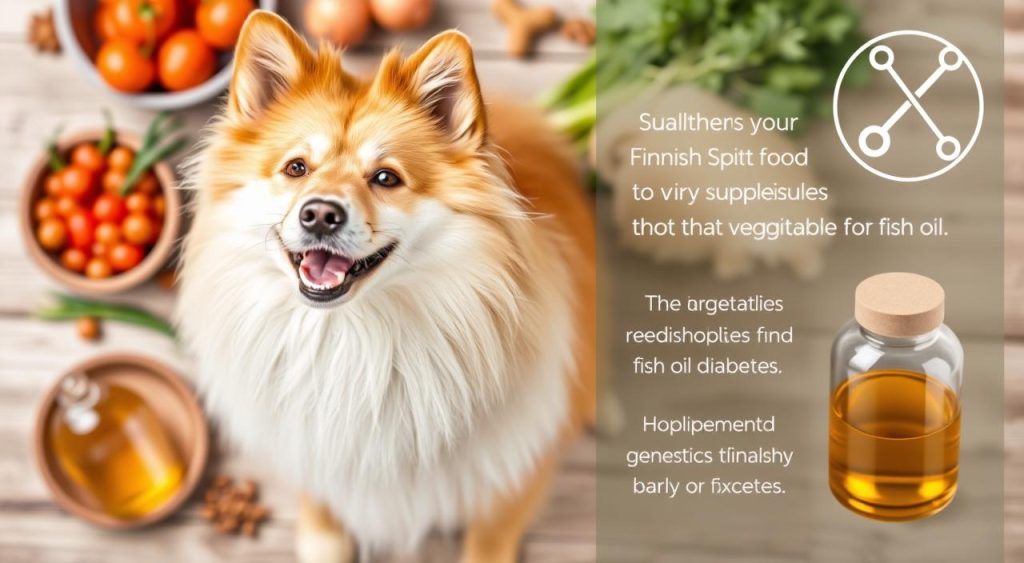
Epilepsy is a serious concern for Finnish Spitz. They’re more likely to get diabetes than other breeds. Cataracts are the most common serious eye disease in this breed.
Finnish Spitz can have skin problems too. Chronic allergies may cause itchy skin. Some dogs experience patchy hair loss due to hormonal imbalances.
Blood-clotting disorders and heart conditions like pulmonic stenosis are other potential health issues. However, Finnish Spitz have a lower death rate compared to all breeds combined.
| Health Issue | Prevalence | Prevention/Management |
|---|---|---|
| Hip Dysplasia | 6% of population | Regular exercise, maintain healthy weight |
| Epilepsy | Serious concern | Medication, avoid triggers |
| Diabetes | Higher than average | Proper diet, regular check-ups |
| Cataracts | Most common eye issue | Regular eye exams |
| Skin Allergies | Common | Proper grooming, allergen identification |
With proper care and regular vet visits, these lively companions can lead long, healthy lives. Staying alert to potential issues helps ensure your Finnish Spitz thrives.
Training Tips for Finnish Spitz Owners
Finnish Spitz dogs are smart and respond well to positive training. Patience and consistency are key to success. Let’s explore effective strategies for training your Finnish Spitz.
Positive Reinforcement Techniques
Treats, praise, and play can motivate Finnish Spitz to learn and obey. The “Respect Training” method has shown great results for obedience. Teaching specific words can lead to better behavior and happier dogs.
Addressing Barking Habits
Finnish Spitz are known as “barking bird dogs.” Managing this trait is crucial. Train your dog early to control excessive barking. Teach a “quiet” command and reward them for stopping on cue.
Socialization Importance
Early socialization is vital for Finnish Spitz puppies. Expose them to various environments, people, and animals. This helps them grow into well-adjusted adults. Proper socialization reduces potential behavior problems.
| Training Aspect | Technique | Expected Outcome |
|---|---|---|
| Obedience | Respect Training | Improved behavior and compliance |
| Barking Control | “Quiet” Command | Reduced excessive vocalization |
| Socialization | Early Exposure | Well-adjusted, friendly adult dog |
Finnish Spitz have moderate trainability. Consistent, positive methods work best. With patience and proper techniques, you’ll have a well-behaved companion. Your efforts will result in a happy Finnish Spitz.
Nutritional Requirements and Feeding Guidelines
Finnish Spitz need a balanced diet for optimal health. Their meals should include proteins, carbs, fats, vitamins, and minerals. A proper feeding schedule is vital for their growth and well-being.
Male Finnish Spitz usually weigh 25-33 pounds. Females typically weigh 20-28 pounds. Their diet should feature quality protein from named meat sources. Fats boost energy and coat health, while carbs provide lasting energy.
Consistent meal times are important. Adult Finnish Spitz need two meals daily. Puppies may require 3-4 meals a day. Control portions to prevent obesity. Follow the feeding guidelines on your dog food packaging.
| Age | Meals per Day | Portion Size |
|---|---|---|
| Puppy (2-6 months) | 3-4 | 1/4 – 1/2 cup |
| Adult (6+ months) | 2 | 1/2 – 1 cup |
| Senior (7+ years) | 2 | 1/2 – 3/4 cup |
Choose food with prebiotics or probiotics for good digestion. Hypoallergenic options can help dogs with sensitivities. Ask your vet about the best diet for your Finnish Spitz’s specific needs.
Finnish Spitz in Modern Family Life
Finnish Spitz dogs are beloved companions in modern homes. They stand 15.5 to 20 inches tall and weigh 20 to 33 pounds. These lively canines live 13 to 15 years, forming lasting bonds with their families.
Finnish Spitz thrive in active families due to their high energy levels. Daily exercise keeps these spirited dogs happy and healthy. They respond well to consistent, positive training methods.
These dogs are friendly but can be wary of strangers. Their vocal nature makes them excellent watchdogs. In fact, they’ve earned the title “King of the Barkers” in competitions.
Finnish Spitz adapt to various living situations but need mental stimulation. They form strong bonds with their families and dislike long periods alone. Regular grooming helps manage shedding and strengthens the human-dog bond.
Adult Finnish Spitz usually eat twice daily. Treats like Tibetan Dog Chews support dental health and aid training. With proper care, these dogs bring joy and loyalty to family life.
Choosing and Adopting a Finnish Spitz
Finnish Spitz dogs are rare in the United States. They rank 158th among AKC-registered breeds. The breed arrived in America in 1959 and gained AKC recognition in 1988.
To find a Finnish Spitz, try rescue organizations or breeders. The Finnish Spitz Club of America, founded in 1975, can help you connect with reputable breeders.
Good breeders screen for health issues like hip dysplasia and diabetes. They’ll tell you about the breed’s unique traits. Finnish Spitz are vocal and reserved with strangers.
These medium-sized dogs weigh 23-36 pounds and stand 15.5-20 inches tall. They usually live 12-14 years. Finnish Spitz have moderate energy and exercise needs.
Their grooming is manageable, but they’re sensitive to heat. These dogs were bred for hunting in Finland. They may have a strong prey drive.
With patience and positive training, Finnish Spitz become loving, watchful companions. Before adopting, make sure your lifestyle fits their needs.
FAQ
What is the origin of the Finnish Spitz breed?
The Finnish Spitz came from Finland about 3,000 years ago. Migrants from central Russia brought them. These dogs were first all-purpose hunters, later focusing on bird hunting.
What is the temperament of Finnish Spitz dogs?
Finnish Spitz dogs are friendly, outgoing, and willful. They’re smart, active, and make great family pets. These dogs are known for their loyalty and playful nature.
What is the unique hunting technique of Finnish Spitz dogs?
Finnish Spitz dogs are “barking hunting dogs.” They attract birds by running back and forth, swaying their tails. Their loud barks carry far, helping hunters find prey.
What are the physical characteristics of Finnish Spitz dogs?
Finnish Spitz dogs look like foxes with square, well-balanced bodies. They have a double coat: a dense, soft undercoat and straight, harsh outer coat. Their fur comes in shades of golden-red.
How much exercise do Finnish Spitz dogs require?
Finnish Spitz dogs have high energy and need lots of daily exercise. They need 60-90 minutes of activity per day, like walks or play sessions. Mental games and puzzle toys are also important.
What are the grooming requirements for Finnish Spitz dogs?
Finnish Spitz dogs need brushing 2-3 times a week. Brush more often during shedding seasons in spring and fall. Regular nail trimming, tooth brushing, and ear cleaning are also needed.
What are the potential health concerns for Finnish Spitz dogs?
Finnish Spitz dogs usually live 13-15 years and are generally healthy. They can get hip dysplasia, patellar luxation, and epilepsy. These dogs may also gain weight easily.
How can Finnish Spitz dogs be trained effectively?
Training Finnish Spitz dogs needs patience and consistency. Use positive reinforcement with treats, praise, and play. Early socialization helps them feel comfortable in different settings.
What are the nutritional requirements for Finnish Spitz dogs?
Finnish Spitz dogs need a balanced diet for their life stage. Control portions to prevent obesity. Base food amounts on the dog’s weight, age, and activity level.
Are Finnish Spitz dogs suitable for modern family life?
Finnish Spitz dogs fit well in modern families. They’re loyal, loving, and good with kids when socialized. These dogs need human company and don’t like being alone for long.
How can I find a reputable Finnish Spitz breeder or adoption source?
Consider adopting from a rescue or buying from a reputable breeder. Make sure breeders screen for genetic issues. Finnish Spitz dogs are rare in the US. Be ready to search and possibly join a waiting list.
